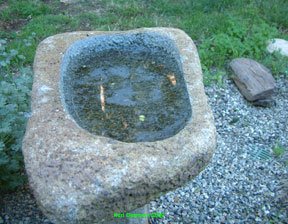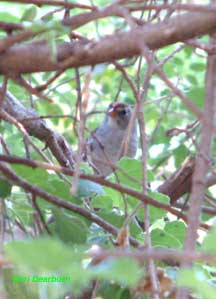

Beauty comes in many forms. For me the Jerusalem cricket is just as beautiful as the monarch butterfly. I know. You think I’m crazy. How can I compare the delicate finery of a dazzling butterfly with its bold black-and-orange stripes and clown-like, white polka-dotted body to the naked brown of an earth-burrowing, spiky-toed “potato bug.”
It’s easy really, if you get to know them as individuals.
Yes, the monarch floats through the air on elegant wings, but look closer. The monarch sipping from my buddleja has been around the block. There is a chunk missing from its right lower wing–possibly a bite taken by a predator during the summer. This tough guy is probably headed to a temperate spot to spend the winter with some of his buddies.

The black dot in the thicken stripe on his posterior wings, shows that this is a male. Those dots are scent glands. Each flutter of his wings spreads a pheromone calling card to females looking for love. He doesn’t beat his wings to look angelic, his agenda is sex.
Can you really call him delicate? No. I have helped tag pugnacious monarchs. They are strong little creatures that wriggle and push their way out of your grasp. Rub the colored scales off their wing and the resulting clear chitin window provides a resilient surface for a stick-on tag. This monarch is a tough guy, a scrapper, a butterfly that can migrate hundreds of miles one 6-inch wingspan at a time.
 Now look again at the Jerusalem cricket. Her glossy round, honey-colored head with small brown eyes can look somewhat human, hence the name “Niñas de la Tierra” or earth child. Many in the Hispanic community see her head as skull-like, a death head. But she isn’t poisonous, she isn’t a killer. Typically the Jerusalem cricket spends her days underground in moist soil emerging at night to munch on plant roots and decaying matter. Some call her potato bug, though this female wouldn’t touch potato.
Now look again at the Jerusalem cricket. Her glossy round, honey-colored head with small brown eyes can look somewhat human, hence the name “Niñas de la Tierra” or earth child. Many in the Hispanic community see her head as skull-like, a death head. But she isn’t poisonous, she isn’t a killer. Typically the Jerusalem cricket spends her days underground in moist soil emerging at night to munch on plant roots and decaying matter. Some call her potato bug, though this female wouldn’t touch potato.I had this girl in captivity for two weeks while I was teaching a class on arthropods. We found her out for a late night stroll hunting for a suitor. Jerusalem crickets don’t waft their scent like butterflies, instead they drum their abdomens on the ground to call in a mate with irresistible tribal tunes. Each subspecies drums their own rhythm.
 During the day, she slept buried in dirt. Her diurnal slumber was deep. The first time I checked her during the day, I thought she had perished. When she awoke with a start, we both jumped. Once I understood her routine, I knew to expect this party girl wasn’t raring to go until 10:00 at night.
During the day, she slept buried in dirt. Her diurnal slumber was deep. The first time I checked her during the day, I thought she had perished. When she awoke with a start, we both jumped. Once I understood her routine, I knew to expect this party girl wasn’t raring to go until 10:00 at night.Yes, she has large jaws which could give you a nip, but she needs them to gnaw. Of the food we offered, carrots were her favorite. Her feet are spiky and her claws can appear threatening if she is flipped on her back. But a Jerusalem cricket is a tasty high-protein snack for a skunk, bat or island fox. She needs those claws for digging, climbing and protecting herself. She isn’t toxic like the monarch.
While her carmel-colored body appears slightly chunky, her long flexible antennae wave about with the fluidity of a Hawaiian dancer. With six legs in motion, she moves rapidly, especially on a smooth surface.
She was at her most beautiful, however, climbing over bark and branches, making her way back into the night when we released her. Her clawed feet purposefully carried her across the rough terrain. Her antennae flicked out in front of her recognizing the nooks and crevasses of her neighborhood.
Both the monarch and the Jerusalem cricket are adapted perfectly for the lives they lead, I can’t think of a better definition of beauty.


